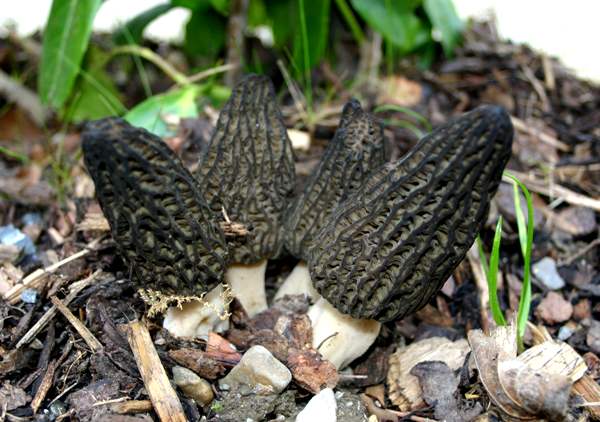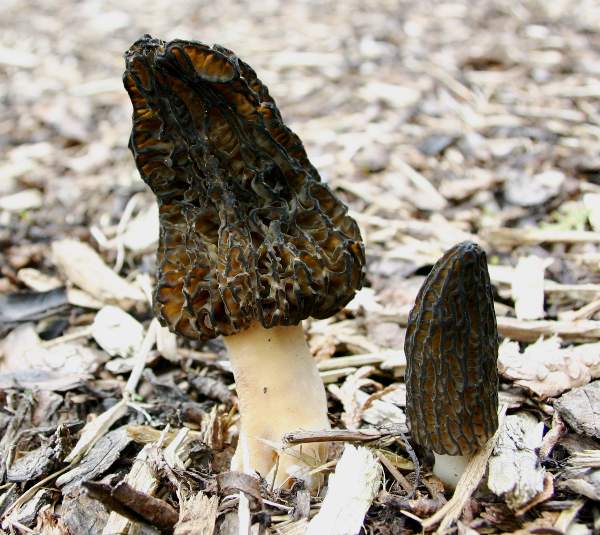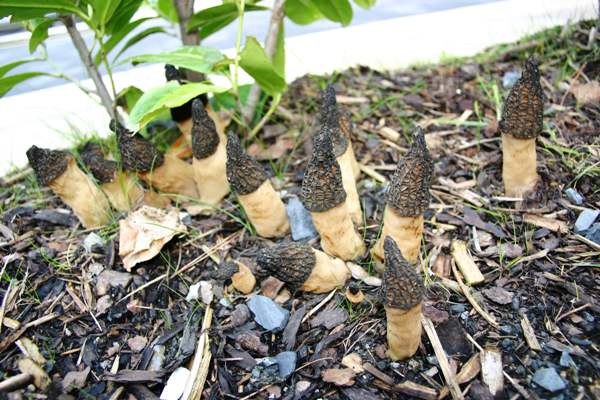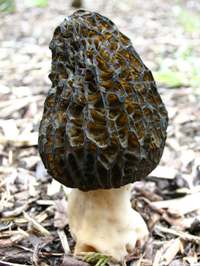Morchella elata Fr. - Black Morel
Phylum: Ascomycota - Class: Pezizomycetes - Order: Pezizales - Family: Morchellaceae
Distribution - Taxonomic History - Etymology - Toxicity - Identification - Culinary Notes - Reference Sources

Not so long ago, it was widely believed that there were very few distinct morel species - indeed, some authorities recognised as few as just three worldwide. Latterly, molecular studies have shown that there are several dozen separate species and that, for example, European and North American morels which may look very similar are in most cases not cospecific. For most amateurs, however, two phylogenic clades (groups closely related in evolutionary terms) are of particular note and are represented on this website. The most famous of these groups, the Morchella esculenta clade, comprises close relatives of the yellowish morels, and generally they seem to be associated with broadleaf trees, possibly even with some form of mycorrhizal connection. The other clade of note that is commonly seen is relatives of the so-called Black Morel Morchella elata and its relatives, which is found on woodchip mulch and may form some kind of ecological association with conifer trees. This page is about thye latter group.
Morchella elata, the Black Morel, fruits from March to June and is a popular edible fungus, although less well known than the Common Morel, Morchella esculenta. Found in woods and forests, particularly beside woodland tracks, this swarthy morels often fruit in groups. In gardens and parks where bark mulch has been laid to reduce the need for weeding, Black Morels sometimes spring up in vast swathes, but unfortunately their appearance one year is no guarantee of a crop of morels in future years.

Distribution
Usually abundant where it does occur, in Britain the Black Morel is increasingly common in the south of England and the Midlands, where bark mulch is its stronghold habitat. This ascomycetous mushroom is also fairly common in South Wales. Fewer Black Morels seem to be reported from the north of England and from Scotland, although a pale violet variety, Morchella elata var. purpurescens has been found in Scotland. I have seen thousands of Black Morels (yes, literally thousands!) on bark mulch in County Wicklow, Ireland. On mainland Europe Morchella elata is found from Scandinavia down to the Mediterranean countries; it appears to be particularly common in central and southern European countries.
Black Morels in North America are now known to be a different species from those found in Europe.

Taxonomic history
The Black Morel that we find in Europe was described scientifically in 1822 by the great Swedish mycologist Elias Magnus Fries, who gave it the name Morchella elata. Other synonyms of Morchella elata include Helvella esculenta (L.) Sowerby, Phallus esculentus L., and Morchella rotunda (Fr.) Boud.
Etymology
The generic name Morchella is said to come from morchel, an old German word meaning 'mushroom', while the specific epithet elata is Latin and simply means tall (elongated, or perhaps that should be elated. I certainly do get a feeling of elation whenever I come across a patch of these delicious edible fungi!)
Toxicity
Although they are highly prized edible mushrooms, Morels of all types, including Morchella elata, must always be cooked thoroughly; otherwise they can cause severe stomach pains and sickness. The hydrazine toxins that cause these reactions are destroyed during the cooking process.
There is a risk of confusing Morchella elata with the deadly poisonous False Morel Gyromitra esculenta, whose cap has a paler brain-like surface rather than a pitted surface.
Identification guide
 |
Cap3 to 8cm in diameter and 6 to 8cm tall; stems of Morchella elata are 1 to 3cm diameter and 4 to 10cm tall. The hollow conical or egg-shaped cap of this popular edible species is deeply pitted, rather like an irregular honeycomb. Within the pits the surface varies from pale brown to grey and darkens with age. The vertical ridges are continuous and for the miost part fairly well aligned, while the more randomly spaced horizontal ridges that run between pairs of vertical ridges are noticeably narrower. StemSmooth at the top but usually grooved near the base, the stem of Morchella elata has just one hollow chamber. |
Asci300 x 20µm; eight spores per ascus. SporesEllipsoidal, smooth, 18-25 x 11-15µm; hyaline; with an oil droplet at each end. Spore printPale cream. |
|
Odour/taste |
Not distinctive. |
Habitat & Ecological role |
Black Morels appear on rich, well-drained soil under trees; often beneath hedges or on disturbed soil at the edge of a garden. Increasingly they are being found on conifer bark chippings used as mulch in parks and gardens, which suggests that they are, in these kinds of habitats at least, saprobic. |
Season |
March, April and May in Britain and Ireland. |
Similar species |
Morchella esculenta has a paler pitted cap and is usually less pointed. Gyromitra esculenta has a red-brown, brain-like cap and a stipe that is hollowed into several chambers. Helvella crispa has a fluted, broader stem with external grooves and internal hollow channels. |
Culinary Notes
We always dry our Morels, including Morchella elata, partly because we are convinced that the process improves their flavour but mainly because they are too good to have them available only in springtime. Dried Black Morels in a sealed container will last indefinitely... if you can resist making a meal of them.
Morels are very good when fried in butter and served on toast with a creamy sauce. We also make mushroom soup and serve it in dishes with one whole Morel floating in the middle with a small splash of fresh cream. Last, but probably best of all, Morels are marvelous when served with a meat dish such as beef or pork and a selection of roasted vegetables.
Reference Sources
Pat O'Reilly 2016, Fascinated by Fungi; First Nature
Dennis, R.W.G. (1981). British Ascomycetes; Lubrecht & Cramer; ISBN: 3768205525.
Breitenbach, J. & Kränzlin, F. (1984). Fungi of Switzerland. Volume 1: Ascomycetes. Verlag Mykologia: Luzern, Switzerland.
Medardi, G. (2006). Ascomiceti d'Italia. Centro Studi Micologici: Trento.
Dictionary of the Fungi; Paul M. Kirk, Paul F. Cannon, David W. Minter and J. A. Stalpers; CABI, 2008
Taxonomic history and synonym information on these pages is drawn from many sources but in particular from the British Mycological Society's GB Checklist of Fungi.
Fascinated by Fungi. Back by popular demand, Pat O'Reilly's best-selling 450-page hardback book is available now. The latest second edition was republished with a sparkling new cover design in September 2022 by Coch-y-Bonddu Books. Full details and copies are available from the publisher's online bookshop...

